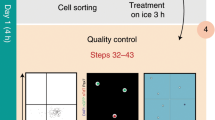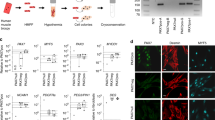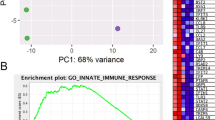Abstract
This study was aimed at evaluating the in vitro and in vivo haematopoietic potential in macaque skeletal muscle cells. Biopsy samples showed the presence of CD34+ (7.6%), CD90+ (8.4%), CD117+, CD31+, side population (SP) cells (7–10%) and a low number of CD45+ cells. In clonogenic and long-term culture-initiating cell assays, no haematopoietic potential could be detected in either total mononuclear cells or SP cells. Regarding in vivo studies, two animals were transplanted with unfractionated fresh muscle cells after lethal irradiation. Both animals died early after transplant without any evidence of haematopoietic reconstitution. In two other monkeys, harvested muscle cells were frozen and secondarily marked using a green fluorescent protein (GFP)-lentiviral vector. After sublethal irradiation, both animals were transplanted with GFP-expressing muscle cells followed by a bone marrow rescue. Both animals had haematopoietic reconstitution at days 22 and 25, but no GFP-expressing haematopoietic cells could be detected by flow cytometry, either in the blood or in clonogenic cells from marrow aspirates. Using PCR assays, GFP+ cells were detected in a single marrow sample of one animal at 41 days after transplantation. These results strongly suggest that as opposed to murine muscle, the non-human primate skeletal muscle does not harbour cells with a straightforward haematopoietic potential.
This is a preview of subscription content, access via your institution
Access options
Subscribe to this journal
Receive 12 print issues and online access
$259.00 per year
only $21.58 per issue
Buy this article
- Purchase on Springer Link
- Instant access to full article PDF
Prices may be subject to local taxes which are calculated during checkout



Similar content being viewed by others
References
Gussoni E, Soneoka Y, Strickland CD, Buzney EA, Khan MK, Flint AF et al. Dystrophin expression in the mdx mouse restored by stem cell transplantation. Nature 1999; 401: 390–394.
Jackson KA, Mi T, Goodell MA . Hematopoietic potential of stem cells isolated from murine skeletal muscle. Proc Natl Acad Sci USA 1999; 96: 14482–14486.
Farace F, Prestoz L, Badaoui S, Guillier M, Haond C, Opolon P et al. Evaluation of hematopoietic potential generated by transplantation of muscle-derived stem cells in mice. Stem Cells Dev 2004; 13: 83–92.
Issarachai S, Priestley GV, Nakamoto B, Papayannopoulou T . Cells with hemopoietic potential residing in muscle are itinerant bone marrow-derived cells. Exp Hematol 2002; 30: 366–373.
McKinney-Freeman SL, Jackson KA, Camargo FD, Ferrari G, Mavilio F, Goodell MA . Muscle-derived haematopoietic stem cells are hematopoietic in origin. Proc Natl Acad Sci USA 2002; 99: 1341–1346.
Kawada H, Ogawa M . Bone marrow origin of hematopoietic progenitors and stem cells in murine muscle. Blood 2001; 98: 2008–2013.
Bradley TR, Metcalf D . The growth of mouse bone marrow cells in vitro. Aust J Exp Biol Med Sci 1966; 44: 287–299.
Asakura A, Rudnicki MA . Side population cells from diverse adult tissues are capable of in vitro hematopoietic differentiation. Exp Hematol 2002; 30: 1339–1345.
Haond C, Farace F, Guillier M, Lecluse Y, Mazurier F, Vainchenker W et al. Quantitative and qualitative analysis of stem cell potential of hematopoietic cells purified from murine muscle. Cell Res 2007; 17: 783–797.
Gao C, Kang EM, Kuramoto K, Agricola BA, Metzger M, von Kalle C et al. Retrovirally transduced muscle-derived cells contribute to hematopoiesis at very low levels in the nonhuman primate model. Mol Ther 2003; 8: 974–980.
Mahmud N, Weiss P, Li F, Hoffman R . Primate skeletal muscle contains cells capable of sustaining in vitro hematopoiesis. Exp Hematol 2002; 30: 925–936.
Jay KE, Gallacher L, Bhatia M . Emergence of muscle and neural hematopoiesis in humans. Blood 2002; 100: 3193–3202.
Dell'Agnola C, Rabascio C, Mancuso P, Capillo M, Pruneri G, Gobbi A et al. In vitro and in vivo hematopoietic potential of human stem cells residing in muscle tissue. Exp Hematol 2002; 30: 905–914.
Allan DS, Jay KE, Bhatia M . Hematopoietic capacity of adult human skeletal muscle is negligible. Bone Marrow Transplant 2005; 35: 663–666.
Howell JC, Yoder MC, Srour EF . Hematopoietic potential of murine skeletal muscle-derived CD45(−)Sca-1(+)c-kit(−) cells. Exp Hematol 2002; 30: 915–924.
Author information
Authors and Affiliations
Corresponding author
Rights and permissions
About this article
Cite this article
Haond, C., Drouet, M., Derdouch, S. et al. In vitro and in vivo evaluation of the haematopoietic potential of skeletal muscle in a non-human primate model. Bone Marrow Transplant 41, 579–584 (2008). https://doi.org/10.1038/sj.bmt.1705941
Received:
Revised:
Accepted:
Published:
Issue Date:
DOI: https://doi.org/10.1038/sj.bmt.1705941



